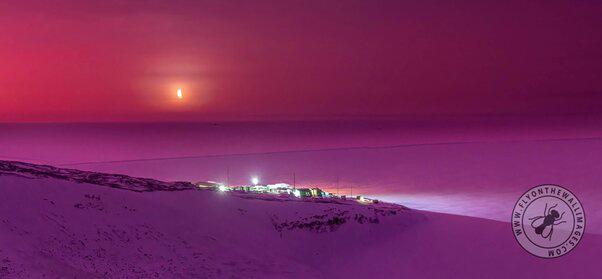Science Tonga Volcano Eruption Causes Pink Atmospheric ‘Afterglow’ Above Antarctica David Bressan Contributor Opinions expressed by Forbes Contributors are their own. I deal with the rocky road to our modern understanding of earth New! Follow this author to improve your content experience. Got it! Jul 16, 2022, 07:51am EDT | Share to Facebook Share to Twitter Share to Linkedin The skies above Antarctica are glowing purple in the aftermath of the Tonga eruption.
NIWA Scientists working in Antarctica have captured breath-taking photos of the skies above the icy continent, including these mesmerizing shots taken by Antarctica New Zealand science technician Stuart Shaw, who is stationed at Scott Base for the winter in the Southern Hemisphere. “Usually in mid-winter, Antarctica is nearly continuously dark, except for a slight ‘nautical twilight’ at around midday which means the horizon is faintly visible in good conditions. But this year, we were presented with quite a show, which had most of the station personnel grabbing jackets and running outside with their cameras to look at the awesome colors.
Believe it or not, I haven’t edited these shots either, they are pretty much as we saw it. It’s incredible,” said Mr. Shaw.
He was prompted to share the images after seeing a story from the National Institute of Water and Atmospheric Research (NIWA) about unusually pink skies in New Zealand, caused by remnant aerosols in the stratosphere from January’s Tongan volcanic eruption , which made him realize that he was seeing the same effect at the bottom of the world. NIWA forecaster Nava Fedaeff says that satellite data shows an abundance of aerosols in the stratosphere between 15 and 24 kilometers above Antarctica, which weren’t present before the eruption. MORE FOR YOU New Research Finds A Connection Between Domestic Violence And These Two Personality Disorders This Scientist Helps Andean Forests And Ecuador’s Women In STEM Exceptional Fossil Preservation Suggests That Discovering Dinosaur DNA May Not Be Impossible Enhanced aerosol detection in stratospheric layer above Antarctica.
N. Fedaeff/NIWA “Stratospheric aerosols can circulate the globe for months after a volcanic eruption, scattering and bending light as the sun dips or rises below the horizon, creating a glow in the sky with hues of pink, blue, purple, and violet . These volcanic twilights are known as ‘afterglows,’ with the color and intensity dependent on the amount of haze and cloudiness along the path of light reaching the stratosphere,” said Ms.
Fedaeff. The aerosols are mostly sulfate particles, but as this was an undersea eruption, water vapor droplets as well as sea salt are also likely to be in the mix. “Nature never fails to put on a show in Antarctica, and it can be beautiful or destructive,” says Antarctica New Zealand’s Chief Science Advisor Jordy Hendrikx.
“These photographs capture the awe it inspires, and how connected our planet is. Antarctica is some 5,000 kilometers from New Zealand, some 7,000 kilometers from Tonga, but we share our skies. ” “What happens in Antarctica affects us at home, and the other way around too.
Much of the science that we support aims to understand those dynamics in the atmosphere, oceans, and ecosystems, and to help better understand the connectivity between Antarctica, New Zealand, and the wider world. ” David Bressan Editorial Standards Print Reprints & Permissions.
From: forbes
URL: https://www.forbes.com/sites/davidbressan/2022/07/16/tonga-volcano-eruption-causes-pink-atmospheric-afterglow-above-antarctica/



